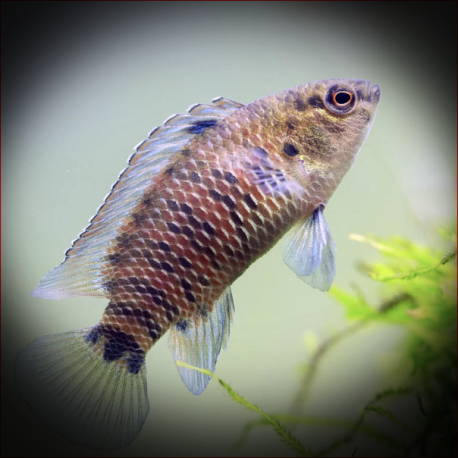More info
Datasheet
| Minimum Tank Size | 60 litres / 15.85 US gallons |
| Maximum Size | 5.0cm / 1.97inches |
| Temperature | 15°C / 59.00°F - 25°C / 77.00°F |
| Hardness | 1.01dgH / 18ppm - 5.04dgH / 90ppm |
| pH | 6.5-7.5 |
General Description
Burmese Badis, scientifically known as Badis Ruber, is a member of the Badidae family within the Perciformes order. It is a slow-moving, micropredator fish that feeds on small aquatic crustaceans, worms, insect larvae, and zooplankton. Adult specimens typically reach a maximum size of 5.0cm.
Aquarium Setup
To house B. ruber, a tank of at least 60 litres should be provided. The setup should include a sand or gravel substrate, water-worn rocks, pebbles for cover, and cave-like structures for potential spawning sites. Plant species like Microsorum, Taxiphyllum, or Anubias can be added for decoration. Light filtration and subdued lighting are ideal, with water parameters set at a pH of 6.5-7.5, hardness of 18-90ppm, and a temperature range of 15-25°C.
Behaviour
Burmese Badis are best kept in a community tank with peaceful tankmates like Trigonostigma or small Rasbora species. They are not gregarious and can display aggression towards rival males, especially in smaller tanks. It is essential to provide spaces for each male to establish a territory and plenty of broken lines of sight to avoid conflicts.
Feeding and Diet
These fish are micropredators that feed on small live or frozen foods such as Artemia, Daphnia, or bloodworms. They may not readily accept dried foods and can be picky eaters. It is crucial to offer regular meals of live or frozen foods to maintain their ideal coloration and overall health.
Reproduction & Dimorphism
B. Ruber are cave spawners that form temporary pair bonds during breeding. Males exhibit brighter colors and extended finnage, making them easily distinguishable from females. Spawning can occur if the fish are offered plenty of live and frozen foods, leading to the laying of 30-100 eggs. After spawning, the male guards the eggs and fry, defending the territory against intruders.
Habitat and Distribution
The Burmese Badis is commonly found throughout lowland Myanmar in locations such as roadside ditches, small creeks, and rice fields with abundant vegetation. Their distribution includes river basins such as Ayeyarwady/Irrawaddy, Mu, and Sittaung, as well as minor drainages along the coastlines of Mon State and Tanintharyi Division. They have also been recorded in the Mekong basin in Thailand and Laos.

